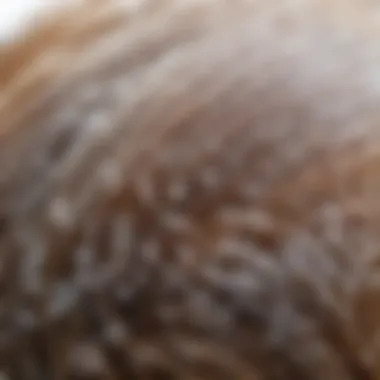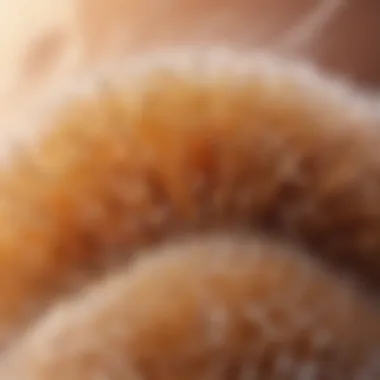Understanding the Multifaceted Causes of Dandruff


Intro
Dandruff, or kepeklenme, is a common scalp condition that affects many individuals across different demographics. Understanding its causes is essential for effective management and alleviation of symptoms. This article explores various contributors to dandruff, including biological, environmental, and personal care factors. By examining these influences, readers will gain insight into how to address this issue, potentially improving their scalp health.
Ürün İncelemesi
Ürün Tanıtımı
An important aspect of managing dandruff is the selection of appropriate hair care products. Many shampoos and treatments are marketed specifically for dandruff management. These products often contain ingredients like ketoconazole, selenium sulfide, and zinc pyrithione, which target the underlying causes of kepeklenme. Choosing the right formulation can make a notable difference in symptom relief.
Ürün Özellikleri
When evaluating effectiveness, consider the following product features:
- Active Ingredients: Look for specific compounds known to combat dandruff.
- Scalp Sensitivity: Some individuals have sensitive skin that reacts poorly to harsh chemicals. Opting for gentler formulations may be beneficial.
- Moisturizing Properties: Dry scalp can exacerbate dandruff. Products with hydrating components can help maintain scalp moisture.
- pH Balanced: Formulations that respect the natural pH of the scalp can promote overall skin health.
Güzellik İpuçları
Doğal Güzellik Yöntemleri
In addition to commercial products, there are various natural methods that people utilize to combat dandruff. Some effective natural remedies include:
- Tea Tree Oil: Known for its antifungal properties. Dilute with a carrier oil and apply to the scalp.
- Apple Cider Vinegar: Can help balance scalp pH. Mix with water and use as a rinse.
- Aloe Vera: Provides soothing relief and hydrates the scalp.
Sağlıklı Beslenme ve Güzellik
Diet plays a significant role in skin and hair health. A balanced diet rich in nutrients can support scalp health. Consider incorporating:
- Vitamins: Biotin, zinc, and vitamins A and E are crucial for skin and hair vitality.
- Healthy Fats: Omega-3 fatty acids found in fish and flaxseeds can hydrate the scalp.
- Hydration: Drink plenty of water to maintain your skin's moisture levels.
"What you eat impacts not just your health, but also the condition of your hair and scalp."
The End
Understanding the causes of kepeklenme involves recognizing the interplay of biological, environmental, and personal care practices. By exploring product options and lifestyle choices, individuals can equip themselves with the tools necessary for effective dandruff management. This knowledge empowers readers to make informed decisions that enhance their overall hair and scalp health.
Preamble to Kepeklenme
Understanding kepeklenme, or dandruff as commonly known, is crucial for both personal and social reasons. This condition can lead to discomfort, reputation issues, and even self-esteem concerns for those affected. Knowledge about its causes assists individuals in managing their symptoms effectively. Therefore, this section delves into what kepeklenme really is and why it matters.
Defining Kepeklenme
Kepeklenme refers to the flaking of the scalp skin, resulting in visible white or yellowish scales in hair and on clothing. The condition can vary in severity, affecting people differently. Understanding the definition provides a baseline for exploring the various factors contributing to kepeklenme.
It can occur due to numerous reasons, including increased oil production or fungal infections. Some individuals experience mild flaking intermittently, while others may suffer from more persistent and extensive scaling. Recognizing these symptoms allows for targeted strategies for relief.
Significance in Cosmetic and Personal Care
The presence of kepeklenme can significantly impact personal grooming and cosmetic choices. It can dictate what products individuals select, ultimately influencing their self-image. A common concern is finding the right shampoo or treatment that not only addresses flakes but also aligns with one’s overall hair and scalp care routine.
Factors to consider include:
- Product formulation: Some ingredients may irritate the scalp further.
- Frequency of washing: Over-washing or under-washing can exacerbate the issue.
- Cultural perceptions: Some societies stigmatize visible dandruff, making its management a social concern.
In aggregates, the implications of kepeklenme stretch far beyond mere discomfort. They touch on identity, wellness, and lifestyle choices, reinforcing the importance of understanding this common yet impactful condition.
"Knowledge about kepeklenme empowers individuals to choose effective treatments and maintain confidence."
Biological Basis of Kepeklenme
Understanding the biological underpinnings of kepeklenme is crucial for comprehending the various factors that contribute to its manifestation. The biological basis encompasses the skin cell renewal cycle, sebaceous gland functions, and the presence of fungi on the scalp. Each of these elements plays a distinct role in either exacerbating or alleviating symptoms associated with dandruff. By approaching this condition from a biological perspective, one can appreciate the complexity and identify potential strategies for management and relief.
Skin Cell Renewal Cycle


The skin cell renewal cycle is the process by which old skin cells are shed and replaced by new ones. This cycle typically lasts around 28 days for a healthy scalp. In cases of kepeklenme, this renewal process may accelerate, leading to an excessive build-up of dead skin cells. When these cells are shed too quickly, they gather on the scalp instead of naturally falling off. This accumulation of cells is visible as flaky white or yellowish scales.
A disrupted skin cell cycle often results from various triggers, such as stress, hormones, and diet. Understanding this cycle is essential for determining suitable treatments. Effectively managing the exfoliation of dead cells can significantly mitigate the visibility of kepeklenme.
Sebum Production and Its Role
Sebum is an oily substance secreted by the sebaceous glands in the skin. It plays a critical role in maintaining scalp health by providing moisture and forming a protective barrier. However, excessive sebum production can lead to a greasy scalp environment, which can be conducive to the overgrowth of certain fungi such as Malassezia. The overabundance of sebum can not only trap dead skin cells but also create an ideal setting for fungal proliferation.
Balancing sebum levels is, therefore, a key consideration in treating dandruff. Appropriate hair products and regular washes can assist in managing the amount of oil on the scalp, helping lessen the symptoms associated with kepeklenme.
Fungal Presence on Scalp
Fungi, particularly the Malassezia species, are naturally found on the scalp. While generally harmless, in certain conditions, they can become problematic. An imbalance in the scalp's ecosystem, often exacerbated by excessive sebum or an improper skin cell renewal process, can lead to the overgrowth of these fungi. This may result in inflammation and irritation, visible through redness and scaling.
The relationship between fungi and scalp health is intricate. An overpopulation of Malassezia can cause a variety of symptoms, reinforcing the importance of maintaining a healthy scalp environment.
Awareness of the role fungi play can guide individuals toward interventions that help restore balance. This may include using antifungal shampoos or adjusting hair care routines to create a less hospitable environment for fungal overgrowth.
In essence, understanding the biological basis of kepeklenme lays a solid foundation for addressing this condition. By considering the skin cell renewal cycle, the role of sebum, and the influence of scalp fungi, individuals can make informed choices regarding treatment and prevention.
Contributing Factors to Kepeklenme
Understanding the contributing factors to kepeklenme is essential for addressing this common condition effectively. Various elements interplay, leading to its appearance. By recognizing these factors, individuals can better manage their symptoms, leading to healthier scalp and hair. This part will delve into genetic predisposition, dietary influences, and environmental factors that impact kepeklenme.
Genetic Predisposition
Genetic predisposition refers to the hereditary factors that may make some individuals more susceptible to kepeklenme. Research suggests that certain genetic traits influence the skin's oil production and immune response, which can exacerbate dandruff.
"Individual skin types often correlate with family backgrounds, indicating a possible genetic link in the prevalence of dandruff."
People with a family history of skin conditions, such as psoriasis or seborrheic dermatitis, may face higher risks of developing kepeklenme. Recognizing this predisposition can help guide preventative strategies, as those at risk may need to adopt more proactive hair and scalp care routines.
Dietary Influences
Dietary choices play a significant role in skin and scalp health. Certain nutrients can promote optimal hair conditions, while deficiencies may lead to worsened symptoms. For example, a diet lacking in omega-3 fatty acids may contribute to a dry scalp, provoking dandruff. Likewise, insufficient zinc or B vitamins can trigger increased skin cell turnover, leading to flaking.
To mitigate kepeklenme through diet, consider incorporating the following:
- Fatty fish like salmon, rich in omega-3s
- Nuts and seeds for essential fatty acids
- Whole grains and fruits that supply B vitamins and zinc
Maintaining a balanced diet not only supports overall health but can significantly impact scalp condition. Paying attention to what you eat could help lessen the occurrence of dandruff.
Environmental Conditions
Environmental factors are crucial in contributing to kepeklenme. Dry air, particularly in winter months, can lead to a dehydrated scalp, making dandruff more prominent. In contrast, humid climates may increase the presence of malassezia, a yeast that exacerbates dandruff through oil production.
Moreover, exposure to pollution and harsh chemicals can irritate the scalp, causing increased flaking. Individuals living in urban areas or those who frequently change their hair care products might find themselves more susceptible.
To counteract these environmental influences, consider:
- Using a humidifier in dry locations
- Choosing mild shampoos free of sulfates
- Regularly moisturizing the scalp with natural oils
By understanding the environment's impact on scalp condition, individuals can take proactive measures to minimize the risk of kepeklenme.
Lifestyle Factors Impacting Kepeklenme
Lifestyle choices play a significant role in the onset and intensity of kepeklenme, commonly known as dandruff. Understanding how specific factors influence the condition can provide valuable insights for effective management. These choices include daily hair care routines, the types of products used, and even stress levels—all of which can exacerbate or alleviate symptoms.
Hair Care Routines
A consistent hair care routine is essential for maintaining scalp health. Neglecting proper hygiene can lead to a build-up of oils and dead skin cells, which might contribute to kepeklenme. Regular washing can help reduce excess sebum and prevent irritation. However, washing too frequently may strip the scalp of necessary oils, making the skin dry and flaky.
It is also important to choose the right shampoo. Look for gentle cleansers that are sulfate-free. Products with natural ingredients, such as tea tree oil or aloe vera, can also promote scalp health without causing irritation. Moreover, considering the temperature of the water used during washing is crucial. Hot water can make the scalp dry, triggering more flaking.


"Keeping the scalp clean and hydrated is vital to managing dandruff effectively."
Product Usage and Sensitivities
The types of products used can have a profound effect on scalp health. Hair care products containing harsh chemicals and fragrances may irritate the scalp and worsen kepeklenme. As individuals often have different sensitivities, it is crucial to identify products that work without causing adverse reactions. Patch testing new hair products can help determine if they will affect the scalp negatively.
Moreover, it’s beneficial to limit the use of styling products that could lead to buildup, such as gels, mousses, and sprays. Always read ingredient labels and avoid those with alcohol, parabens, or artificial fragrances, as they can irritate the skin further. Opting for hypoallergenic or dermatologist-recommended products can be a wise choice.
Stress and Its Effects
Stress is another lifestyle factor that can significantly impact kepeklenme. High stress levels may disrupt normal skin cell turnover and affect the immune system, contributing to an increase in dandruff. Understanding the link between stress and skin health is crucial for individuals dealing with kepeklenme.
Incorporating stress-reduction techniques can be beneficial. Strategies such as mindfulness, yoga, or simply ensuring time for hobbies and relaxation can positively influence overall scalp condition. Tailoring one's lifestyle to manage stress is equally important as direct treatments for kepeklenme itself.
In summary, addressing lifestyle factors impacting kepeklenme opens a pathway to symptom relief. Individuals should be mindful of their hair care routines, the products they use, and their stress management practices.
Potential Medical Conditions Associated with Kepeklenme
Understanding the connection between kepeklenme and various medical conditions is essential for recognizing underlying issues and achieving effective treatment. There are multiple potential medical conditions that can exacerbate or contribute to the symptoms of dandruff. By knowing these connections, individuals can seek appropriate treatments and take preventive measures.
Seborrheic Dermatitis
Seborrheic dermatitis is a chronic inflammatory skin condition that significantly impacts the scalp and often presents with white or yellowish flakes of skin. This condition occurs when sebaceous glands overproduce sebum, creating an oily environment that fosters the growth of Malassezia yeast, a common fungal inhabitant of the scalp. Individuals suffering from seborrheic dermatitis may notice persistent itchiness, redness, and greasy patches on their scalp in addition to visible flakes. Its role in kepeklenme is critical because it often confounds the standard dandruff presentation; in other words, not all dandruff is equal.
Key points to note about seborrheic dermatitis include:
- Individuals with a family history of this condition may be more susceptible.
- Stress, weather changes, and hormonal fluctuations can exacerbate its symptoms.
- Over-the-counter antifungal shampoos can alleviate symptoms, but consulting a dermatologist for persistent cases is advisable.
Psoriasis and Scalp Health
Psoriasis is another skin condition that can affect the scalp, manifesting as red patches covered with thick, silvery scales. This autoimmune disorder influences skin cell turnover, causing rapid production and accumulation of skin cells. While not identical to typical dandruff, the scaly patches can be mistaken for it, often complicating self-diagnosis.
People with scalp psoriasis may face significant discomfort due to the itching and tightness of the skin. It's crucial to identify this condition as it requires distinct treatment options, including prescription topical medications or phototherapy. Notably, psoriasis can arise in individuals with a family history of the disorder, making genetic predisposition an important factor to consider in the discussion of scalp health.
Allergic Reactions
Allergic reactions can also be a potential cause or exacerbating factor in the presentation of kepeklenme. Certain hair care products can contain irritating ingredients that lead to an allergic response, resulting in dermatitis-like symptoms. Common allergens include fragrances, preservatives, and colorants, all of which may trigger inflammation of the scalp.
When using new products, it is crucial to be vigilant for signs of reaction, such as:
- Itching and irritation on the scalp
- Redness and swelling
- Increased flaking and sensitivity
If allergic reactions are suspected, it may be beneficial to conduct a patch test before applying a new product wholly. If symptoms persist despite making changes to personal care routines, medical consultation is warranted.
Preventive Measures Against Kepeklenme
Preventive measures against kepeklenme, or dandruff, play a vital role in maintaining scalp health and overall comfort. The integration of proper practices can significantly reduce the occurrence or severity of this condition. Understanding preventive strategies helps individuals tailor their hair care and lifestyle choices, making a substantial difference in their experience with kepeklenme. This section elucidates effective hair care products, nutritional guidelines for scalp health, and strategies for stress reduction, each contributing to reducing kepeklenme.
Effective Hair Care Products
Choosing the right hair care products is essential for managing dandruff. Products containing ingredients like zinc pyrithione, selenium sulfide, or ketoconazole can effectively combat the yeast that often contributes to dandruff. These ingredients have antifungal properties, helping to control the fungal growth on the scalp.
Moreover, moisturizing shampoos can alleviate dryness, which is a common trigger for increased flakiness. It is crucial to select shampoos tailored to your hair type to avoid irritation. Here are some product categories to consider:
- Anti-dandruff shampoos: Use these regularly to control symptoms.
- Moisturizing conditioners: They help combat dryness and keep the scalp hydrated.
- Scalp treatments: Ingredients like tea tree oil or aloe vera can soothe inflammation and reduce itchiness.
Be cautious with product usage. Over-washing can strip natural oils, while certain styling products may irritate sensitive scalps. Find a balance that supports your hair and scalp health.
Nutritional Guidelines for Scalp Health
A well-balanced diet significantly impacts scalp health. Certain nutrients can support skin and hair, reducing the risk of dandruff. Vitamins such as B vitamins, particularly biotin, are known for their role in skin health. Omega-3 fatty acids found in fish like salmon can help maintain scalp hydration.
Consider incorporating the following foods into your diet:


- Fatty fish: Rich in omega-3s for hydration.
- Nuts and seeds: Excellent sources of essential fatty acids.
- Fruits and vegetables: They provide antioxidants and vitamins necessary for maintaining skin health.
- Whole grains: These can help regulate blood sugar levels, contributing indirectly to scalp condition.
Hydration is equally important. Drinking sufficient water throughout the day helps keep the scalp hydrated and may reduce flakiness.
Creating a Stress-Reduction Plan
Stress is often an underestimated factor contributing to kepeklenme. High stress can lead to hormonal changes that may provoke skin issues, including dandruff. Developing a comprehensive stress-reduction plan can aid in improving scalp health.
Various techniques can help manage stress effectively:
- Mindfulness and meditation: Taking time to relax your mind can be beneficial.
- Regular exercise: Physical activity is known to reduce stress levels and improve overall well-being.
- Adequate sleep: Prioritizing sufficient rest is crucial for skin and hair health.
- Breathing exercises: Simple techniques can help calm the mind, contributing to reduced stress.
It is essential to recognize that managing stress can improve not only one's emotional state but also contribute positively to skin conditions like kepeklenme. Incorporating these aspects into daily life can lead to long-term benefits.
Prioritizing preventive measures can often yield better results than treating symptoms after they occur. Being mindful of hair care, nutrition, and stress levels plays a crucial role in tackling dandruff effectively.
Treatment Options for Kepeklenme
Treatment options for kepeklenme are crucial for individuals seeking relief from dandruff symptoms. Understanding these options can empower people to make informed choices about their scalp health. Each treatment method has its own set of benefits, considerations, and effectiveness, which can vary based on individual needs. This section aims to comprehensively outline these options, ensuring that readers can find a suitable approach tailored to their specific circumstances.
Over-the-Counter Treatments
Over-the-counter treatments are often the first line of defense against kepeklenme. These products are easily accessible in pharmacies and often do not require a prescription. Common active ingredients in these treatments include:
- Zinc pyrithione: Known for its antifungal properties, effective in reducing dandruff.
- Ketoconazole: An antifungal agent that targets the Malassezia fungus, often implicated in dandruff.
- Salicylic acid: Helps in exfoliating the scalp, reducing flakiness and irritation.
- Coal tar: Slows down skin cell turnover and can alleviate the symptoms of dandruff.
These treatments can come in various forms, including shampoos, conditioners, and topical creams. It is important to follow the instructions on the label carefully to maximize effectiveness. Potential side effects may include scalp irritation or dryness, so starting with mild formulations is advisable.
Prescription Medications
In more severe cases of kepeklenme, prescription medications may be required. These are typically recommended for individuals who do not achieve adequate relief from over-the-counter options. Common prescription treatments may include:
- Topical corticosteroids: Reduce inflammation and itching, providing quick relief.
- Stronger antifungal shampoos: For severe fungal infections, leading to dermatological issues.
- Oral antifungal medications: Occasionally necessary for widespread or resistant dandruff conditions.
Consulting a healthcare provider is essential before starting prescription treatments. They can assess the condition and prescribe the most appropriate regimen. Side effects vary and depend on the type of medication used, making professional guidance crucial.
Home Remedies and Natural Solutions
Home remedies and natural solutions offer alternative avenues for managing kepeklenme. Many individuals find these options appealing due to their accessibility and gentler nature. Some common approaches include:
- Tea tree oil: A natural antifungal and antibacterial agent known to reduce symptoms of dandruff.
- Apple cider vinegar: Can help balance scalp pH and may reduce fungal growth.
- Coconut oil: Known for its moisturizing properties, it can soothe a dry, irritated scalp.
- Aloe vera: Offers hydration and can alleviate scalp discomfort.
While these remedies may be less potent than clinical options, they may prevent mild cases from worsening. It is wise to patch-test any new treatment on a small area of skin to avoid adverse reactions.
"Finding the right treatment for kepeklenme often requires a combination of different approaches, tailored to each individual's unique scalp condition."
In summary, treatment options for kepeklenme range from over-the-counter products to prescription medications and home remedies. Consideration of personal preferences, severity of symptoms, and any underlying conditions will guide individuals toward the most suitable solution for achieving healthier scalp skin.
Ending: Understanding and Managing Kepeklenme
Dandruff, or kepeklenme, is a condition that affects a significant portion of the population. Understanding it is vital, not only for symptom management but also for improving overall scalp health. This article has explored the myriad causes of kepeklenme, helping readers identify potential triggers and the biological processes involved. Recognizing these factors empowers individuals to make informed decisions about their personal care routines.
Beyond mere awareness, managing kepeklenme requires a holistic approach. Knowledge gained through this exploration can guide individuals toward effective treatments and lifestyle adjustments, ultimately leading to better control over their symptoms. Acknowledging the role of genetics, diet, and environment will also enhance the understanding of how unique each person's experience with dandruff can be. Thus, the conclusion we draw here is not only about understanding kepeklenme but also about taking actionable steps to alleviate its effects.
Recap of Key Causes
To effectively address kepeklenme, it's crucial to recap the key causes discussed throughout this article:
- Biological Factors: The natural renewal cycle of skin cells and the presence of fungi significantly influence dandruff formation.
- Environmental Conditions: Weather, humidity, and pollution play roles in scalp health.
- Lifestyle Choices: Stress levels, hair care routines, and product sensitivities affect kepeklenme symptoms.
- Medical Conditions: Conditions such as seborrheic dermatitis and psoriasis can exacerbate dandruff.
This overview provides a clear framework for understanding the various components that can lead to or worsen kepeklenme.
Final Thoughts on Management
Ultimately, managing kepeklenme involves an informed, proactive approach. Here are several key considerations for effective management:
- Personalized Treatment: What works for one person may not work for another. Tailoring treatments to the individual's specific needs is essential.
- Consistent Care Routine: Establishing a regular hair care routine with appropriate products can reduce symptoms over time.
- Continued Education: Staying informed about new developments in both treatment options and underlying research can open doors to better management.
- Consultation with Health Professionals: For persistent cases, seeking advice from dermatologists or other specialists can provide additional avenues for treatment and care.
By integrating these practices into daily life, individuals can improve their scalp health and quality of life. Understanding kepeklenme is not just about alleviating symptoms but also about enhancing overall self-care.







